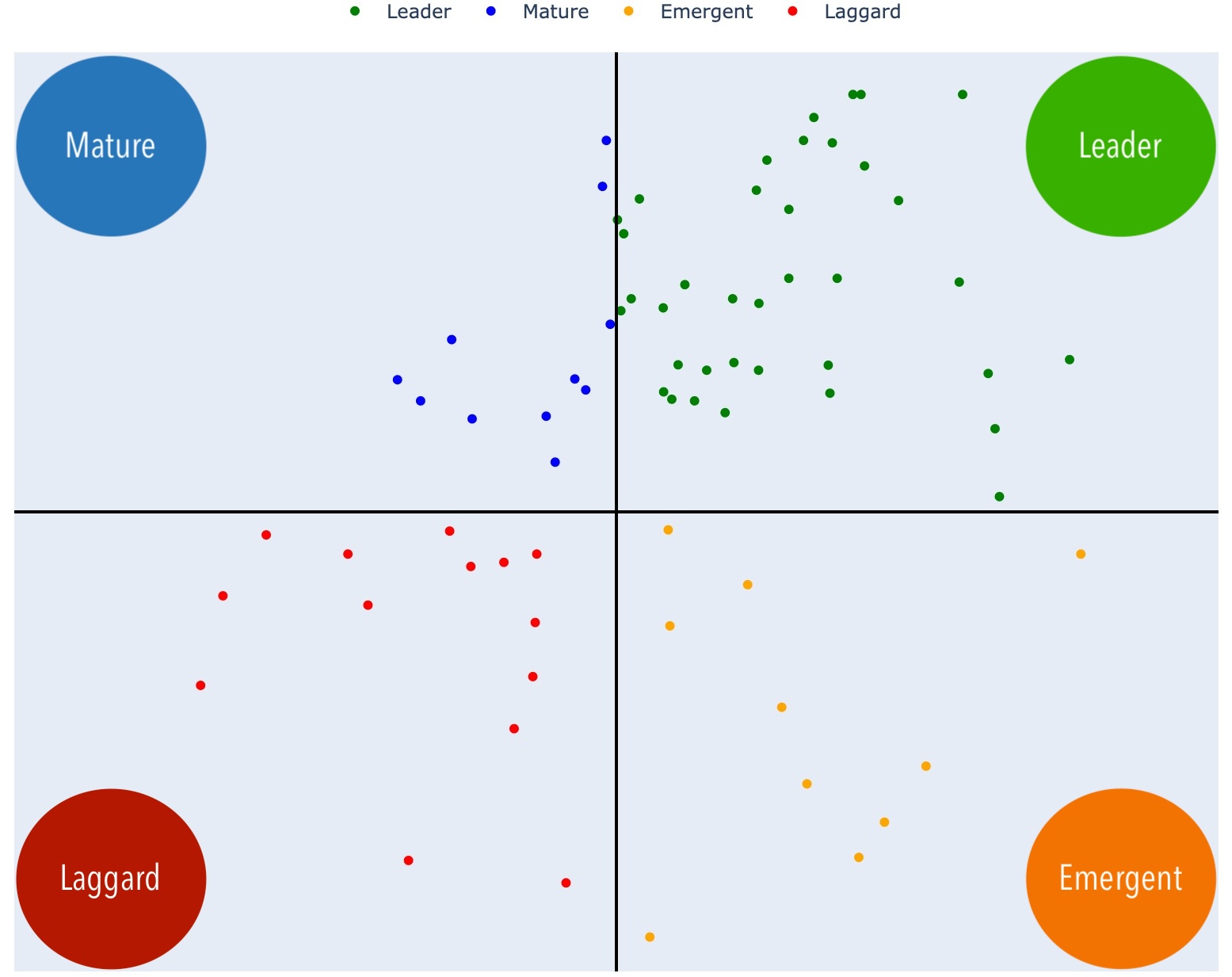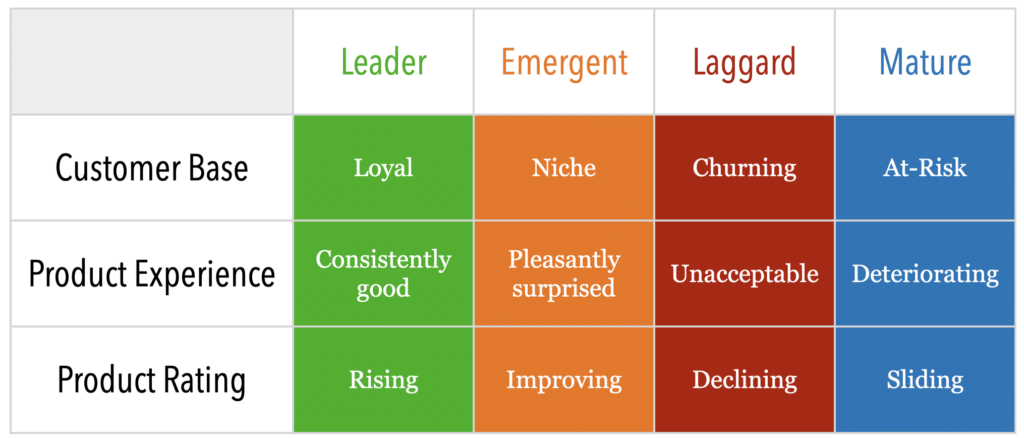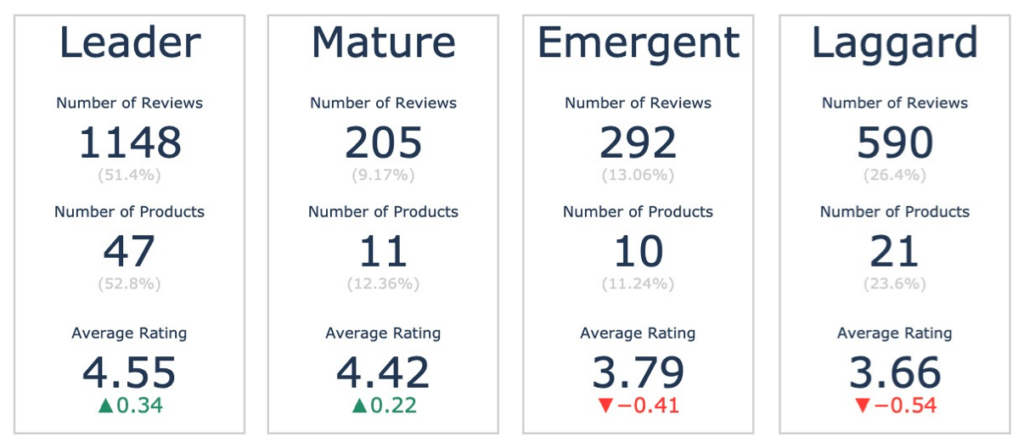In the competitive world of dog food, building a strong brand and earning customer trust are critical for long-term success. Dog owners value product reliability, quality, safety, and ethical standards. Trust is cultivated through positive customer experiences, expert endorsements, and the company’s response to crises and customer service interactions. This blog post delves into the key theme of ‘Brand and Trust’ in dry dog food reviews, focusing on products that fall into four segments: Leader, Mature, Emergent, and Laggard. We will explore what sets a Leader product apart from others and provide actionable insights for marketers and product developers.
Reviews.AI Feedback MatrixTM
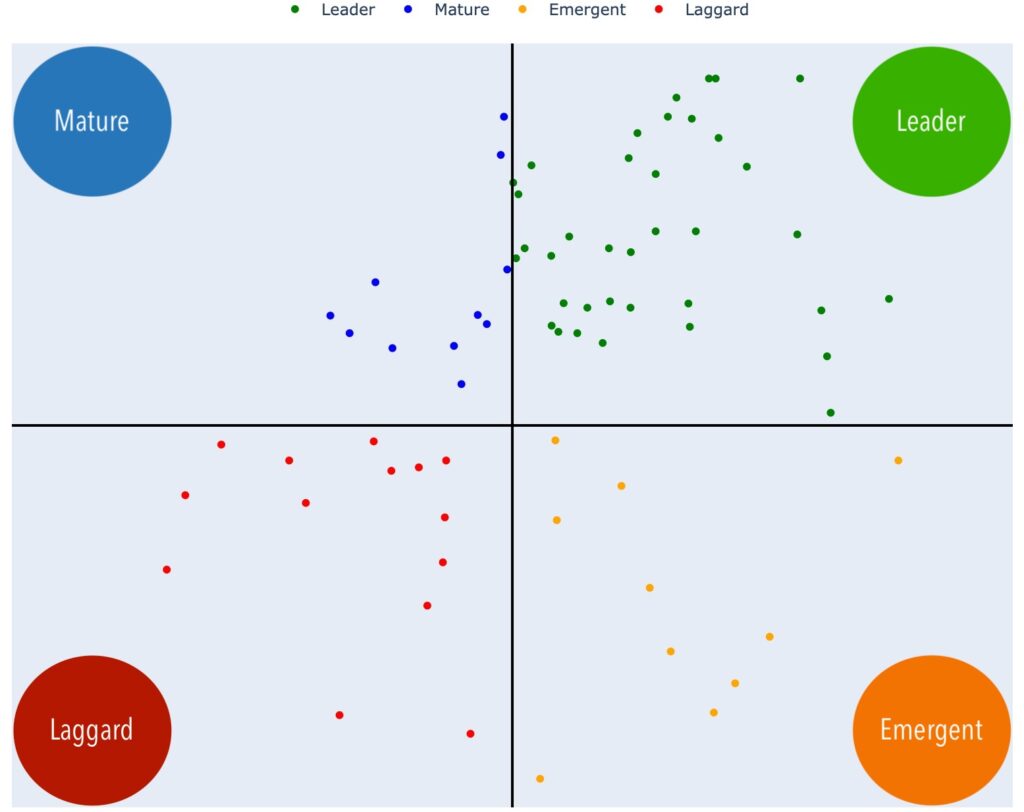 How to read the Reviews.AI Feedback MatrixTM?
How to read the Reviews.AI Feedback MatrixTM?
The matrix maps products in the Dry Dog Food category across four segments
Leader: Shoppers had a favourable perception of the product before purchase, and their expectations were exceeded post purchase
Emergent: Shoppers had a doubtful perception of the product before purchase, but their expectations were exceeded post purchase
Laggard: Shoppers had a doubtful perception of the product before purchase, and it failed to meet their expectations post purchase
Mature: Shoppers had a favourable perception of the product before purchase, but it failed to meet their expectations post purchase
What do the segments mean for your product?
Brand and Loyalty Segments
Leader products are distinguished by positive recommendations, consistent quality, and fulfilled brand promises that exceed expectations and build long-term trust. Mature products initially gain favorable perceptions but fail to maintain them post-purchase, leading to disappointment and betrayal among loyal customers. Emergent products overcome initial skepticism to surpass expectations, often through expert recommendations and positive experiences, thereby building strong trust and loyalty. Laggard products, typically chosen with low expectations due to budget constraints or limited trust, often fail to meet even modest standards, resulting in significant disappointment and regret. This section explores these segments and the qualities that define them in the context of brand and trust among dog food products.
Leader Segment
In the competitive dog food market, certain qualities help products stand out as leaders in brand and trust. Key factors include positive recommendations and reviews that reinforce trust, consistent quality over time that boosts brand loyalty, and the fulfillment of brand promises that delights customers. These attributes ensure long-term satisfaction, reinforce customer loyalty, and highlight the importance of maintaining high expectations set by credible sources. This section explores how these qualities contribute to making a dog food product a leader in brand and trust.
Recommendations and Reviews Build Brand Equity
Customers often rely on recommendations and online reviews to guide their purchases. When expectations are met or exceeded, it reinforces their trust in the product. For example, one customer shared, “Our Golden has been eating this food all of his life (11.5 yrs) and he is healthy and active. It was recommended by our vet when he was a puppy.” This highlights the long-term satisfaction and health benefits that met high expectations set by a trusted veterinarian. Another noted, “We switched over to this brand because of the reviews—it’s cheap, easy to grab (we buy it in Target) our dog loves it, the ingredients are good as well!” The product’s performance matching positive reviews solidified their positive experience. This shows that when products live up to high expectations set by credible sources, customers feel reassured and satisfied.
Consistent Positive Long-term Experience Boosts Trust
Customers who experience consistent quality over time develop strong brand loyalty. This is clear in reviews from dog owners who have used the same brand for years without issues. For example, one review stated, “I have used Purina Pro Plan for the past 15 years without any issues. I started with Pro Plan Puppy and continued on with Pro Plan after their puppy stage. My most recent pup is 8 months old and she, her mother, and her aunt were all started on it as recommended by their breeder.” Another customer mentioned, “Seven years ago when I first got my fur kid, this food was recommended by my vet and she has been eating it daily since then, graduated to Adult Yorkie food. She loves the taste and it is good for her as well.” These experiences suggest that consistent quality over time meets and exceeds customer expectations, reinforcing their trust and satisfaction.
Fulfilled Brand Promise Delights Customers
Customers form strong perceptions about a brand based on its reputation, marketing, and recommendations. When the product experience aligns with high expectations, it leads to delight and increased loyalty. One customer shared, “I have two older dogs, one is 9 and one is 15 years old. I put them on the Pro Plan Adult 7+ sometime ago. They love the taste of this food and I did not have any problems when I switched their food. Always follow recommended procedures for switching food as they tell you how to on the bag. I trust Purina Products as the company is over 100 years old and have the research to back their products. My dogs are in good health and I attribute that to this food!” Another customer, who has been feeding Iams to their dogs since 1988, stated, “I have tried other brands but always come back to IAMS. As a Shih Tzu breeder, there is no other brand I trust more to grow puppies into healthy adult dogs. I just wish they would bring back their breeder program into the US again.” This sentiment shows the customer’s satisfaction and their desire for the brand to expand its offerings beyond dog food. These experiences show that when brands live up to their perceived image, they foster a sense of delight and loyalty.
Mature Segment
In the context of brand and trust, mature dog food products are those that initially garner positive perceptions but ultimately fail to meet customer expectations post-purchase. This section explores how poor experiences, validated by similar online reviews, and issues arising from product changes can lead to a sense of betrayal among long-time users. These negative experiences highlight the challenges faced by products that fail to maintain their initial favorable reputation, ultimately disappointing loyal customers and damaging trust.
Poor Experiences Validated by Online Reviews
Customers who trust a brand for a long time feel especially let down when they have issues with a product they rely on. Discovering that other customers faced similar problems can validate their poor experiences and deepen their disappointment. One customer shared, “I decided to check other reviews on Chewy and I’m very saddened to know others are having similar issues… Very disappointed in Purina. They need to release a recall on this food ASAP! PLEASE READ REVIEWS ON THIS FOOD BEFORE BUYING. DO NOT RECOMMEND THIS BRAND ANYMORE!” This shows how reading similar complaints confirmed their negative experience. Another customer stated, “Happened to look at the reviews for this product after seeing a dip in its rating. Wish I saw them sooner. My dogs have been on this formula for several years. In the last two weeks both my dogs have been violently ill resulting in a trip to emergency care and a very large bill. Was told it may be a dog flu. After reading other reviews, the timeline of the new formula and my dogs being ill seems to be more than just a coincidence. Not happy with this change and not being notified after many years of being a loyal Purina customer. Switching brands immediately.” This customer, after validating their concerns through other reviews, felt betrayed by a brand they had trusted for years.
Realizing Poor Experiences Were Due to Product Changes
When long-time users of a product have issues and then switch brands, they often realize that the problems were due to changes in the product they trusted. This realization leads to a sense of betrayal. One customer explained, “I’ve been feeding my boxer this food for years. This last bag I purchased looked like a completely different formula. The color and shapes are very different. Because it’s a top brand, I figured I can trust it. WRONG! After a couple days he started regurgitating the food along with any water he drank. This happened for 4 days. I switched to a different brand and thank God he’s keeping food and water down. I`ll never trust this brand again.” The customer discovered that the issues were related to a change in the food’s formula. Another review stated, “We had been feeding our Golden Retriever and Goldendoodle this food for over a year now, they liked it and would happily gobble it up, but then we started noticing our Golden Retriever losing her hair, being lethargic, having loose stools, throwing up, and losing her bladder randomly. She went to the vet twice trying to find an answer, but they couldn’t come up with anything, as thyroid, blood work, and urine samples came back normal. Started hearing rumors about Purina causing health problems and immediately changed to Orijen roughly three and a half weeks ago. Within the last three weeks her hair has started growing back, she’s not had any more accidents, now has normal stools and is playing like normal again. We’ll never be feeding Purina again.” This highlights how switching to a new brand revealed that the previous product was the source of their pet’s health issues, leading to a deep sense of disappointment with the original brand.
Emergent Segment
In the realm of brand and trust, emergent dog food products are those that initially face skepticism from shoppers but ultimately exceed expectations post-purchase. This section highlights how initial brand skepticism can be transformed into positive experiences, the unexpectedly positive results of switching brands based on expert recommendations, and the satisfaction of finding the right brand after multiple trials. These qualities showcase the potential for products to win over doubting customers and build strong trust and loyalty through exceptional performance and positive outcomes.
Initial Brand Skepticism Transformed by Positive Experiences
Many customers approach new products with low expectations, especially after reading negative reviews. When their experiences exceed these low expectations, their satisfaction is greatly enhanced. One customer shared, “I was nervous to order this food again after reading the recent reviews and almost changed foods entirely. My dachshund that has had a sensitive tummy his whole life is on his fourth bag after switching from Hills Prescription d/d and is still loving it. So much so that he’s excited with happy twirls at every meal… I don’t write reviews often but wanted to put your mind at ease if you’re an overly protective fur parent like me.” This customer’s initial apprehension was replaced by delight when the product not only suited their dog’s sensitive stomach but also brought visible joy to their pet. Another customer noted, “Puppy chow was upsetting the pup’s belly. Saw some reviews for Purina One and decided to try. Did the 28-day challenge and wow what a difference. P loves it! Her belly problems have disappeared and she is thriving. Definitely would recommend for you to try.” Their low expectations were transformed into a positive experience as their pup’s health improved dramatically.
Switching Brands Leading to Unexpectedly Positive Results
Customers often feel apprehensive about switching to new products, even when recommended by experts. When these recommendations lead to unexpectedly positive results, it enhances their trust and satisfaction. One customer explained, “I’ve been giving my dog a ‘premium’ (super premium?) food for several years. Then they had various recalls for salmonella. Between that and the vet’s recommendation, I switched to Purina One. That was several weeks ago and I’m still amazed at how much my dog loves it. I could put his other food in his bowl and he’d eat it eventually. Pretty much I would put a little gravy or rice on it and he’d eat it. This! I put it out and he eats it right up!” The switch recommended by a vet turned out to be a delightful surprise, with their dog showing an unexpected preference for the new food. Another customer stated, “This high-protein food was Vet recommended to me for her to help keep her healthy. It’s been a godsend to her health. I definitely recommend this puppy food for an aging older dog too.” This endorsement shows how an expert’s recommendation led to a significantly better-than-expected experience, reinforcing their trust in both the product and the expert’s advice.
Finding the Right Brand After Multiple Trials
Some customers have tried various brands before finding the one that works best for their dogs, leading to strong satisfaction when they finally succeed. One review illustrates this journey: “I have fed many different foods to my dogs throughout the years. For many years, plain old dog chow, .. tried many different brands to end up with Purina. I am very happy with the Pro Plan lines. I like that I don’t have to add probiotics and or joint supplements to this line. My 13-year-old has a very fussy tummy and Pro Plan is doing wonders.” The customer’s satisfaction is heightened by the relief of finding a product that meets their dog’s specific needs after many attempts. Similarly, another review states, “My dog loves the Purina one dry dog food! This is the only brand I buy for anymore after trying a couple other brands she definitely preferred the Purina One!” The positive outcome after trying several brands reinforces their loyalty and appreciation for finally finding a suitable product.
Brand and Trust – Laggard
Customers Regret Lack of Prior Research and Bargain Hunting
When customers have low expectations due to budget constraints or a lack of trust in the brand, their negative experiences can be amplified if the product fails to meet even those modest expectations. This is especially true when they realize the extent of the product’s shortcomings through further research. One customer shared, “I bought this food, and after just 5 days of feeding my dog, he got acutely ill. Lethargy, diarrhea, and clear discomfort. Began drinking water nonstop, which is a sign of pancreas or kidney distress. I looked up reviews outside of this website, and it got a whopping 1.5 out of 5, with pages upon pages of other dog owners facing the same issues. We’ve been nursing our dog back on a bland diet (boiled chicken and rice) and he’s slowly improving. I wish I had done my research before putting my dog through this unknowingly.” This review shows how the customer’s low expectations were surpassed by the severity of the negative experience, leading to regret for not having researched more thoroughly beforehand. Another customer stated, “I was trying to save some money on dog food, so I gave WAG a try. This food smelled so awful that my 2.5-year-old Lab wouldn’t even touch it… Too bad the window to return it had already closed! Huge waste of money on this junk!” Here, the customer’s attempt to save money backfired when the product quality did not meet basic standards, resulting in wasted money and disappointment. Similarly, another review noted, “I purchased this dog food for my chow. I bought two different kinds of Wag and mixed both bags in her dog food container. I wanted to switch to something more budget-friendly. She started throwing up almost every other day. Yellowish vomit. I should’ve read more of the one-star reviews before buying. Sophie, my chow, isn’t the only dog who has experienced sickness with this brand.” This customer’s negative experience was compounded by the realization that many others had faced similar issues, reinforcing their regret for not having done more thorough research before purchasing. These reviews show that when customers choose budget-friendly options without thorough research, they often encounter worse-than-expected experiences. The product’s failure to meet even minimal expectations, coupled with subsequent discoveries of widespread dissatisfaction, leads to significant disappointment and regret.
Conclusion
Leader
- Positive reviews and expert recommendations significantly build trust and loyalty.
- Consistent quality over time strengthens brand loyalty and customer satisfaction.
- Fulfilled brand promises lead to delight and increased customer loyalty.
Mature
- Negative experiences validated by similar online reviews can deeply impact customer trust.
- Product changes causing issues lead to a sense of betrayal among long-time users.
- Customers feel particularly let down when a previously trusted product fails to meet expectations.
Emergent
- Low initial expectations can be transformed into high satisfaction through positive product experiences.
- Expert recommendations leading to unexpectedly positive results enhance trust and satisfaction.
- Finding the right brand after multiple trials creates strong loyalty and appreciation.
Laggard
- Lack of prior research and bargain hunting often result in regret when products fail to meet even modest expectations.
- Negative experiences are amplified when realizing widespread dissatisfaction through further research.
- Budget-friendly options without thorough research often lead to significant disappointment and wasted money.
Practical Applications
Leader
- Leverage Positive Reviews and Recommendations: Highlight positive customer reviews and expert endorsements in marketing materials.
- Maintain Consistent Quality: Ensure high-quality standards to build long-term trust and loyalty.
- Fulfill Brand Promises: Align marketing messages with actual product performance to delight customers.
- Engage with Loyal Customers: Foster relationships with long-term customers through loyalty programs and personalized communication.
- Promote Transparency: Share insights into production processes and quality control measures to reassure customers.
Mature
- Monitor Customer Feedback: Regularly check and respond to customer reviews to address concerns promptly.
- Communicate Product Changes: Clearly inform customers about any changes in product formulas to avoid feelings of betrayal.
- Handle Crises Effectively: Develop crisis management plans to maintain trust during negative incidents.
- Rebuild Trust: Engage with dissatisfied customers to resolve issues and restore trust.
- Enhance Customer Service: Invest in training customer service teams to handle complaints empathetically and efficiently.
Emergent
- Address Initial Skepticism: Provide clear, transparent information to alleviate concerns of skeptical customers.
- Showcase Expert Endorsements: Highlight positive recommendations from vets and trainers to build credibility.
- Celebrate Positive Results: Share success stories and case studies of customers who had unexpectedly positive experiences.
- Facilitate Easy Brand Switching: Offer incentives for customers to try your product, making the switch less daunting.
- Support Customer Journeys: Guide customers through the transition to your brand with helpful resources and support.
Laggard
- Encourage Thorough Research: Educate customers about the importance of researching products before purchasing.
- Provide Transparent Reviews: Ensure honest, transparent reviews are easily accessible to potential customers.
- Highlight Quality Assurance: Emphasize quality control measures and certifications to build trust.
- Offer Satisfaction Guarantees: Provide satisfaction guarantees to mitigate risks for budget-conscious customers.
- Address Negative Feedback: Actively seek out and address negative feedback to improve product quality and customer trust.
By understanding the different segments and their unique challenges, marketers and product developers can implement strategies that build and maintain trust in their dog food brands, ultimately fostering a loyal customer base.
Get more actionable insights in the full report
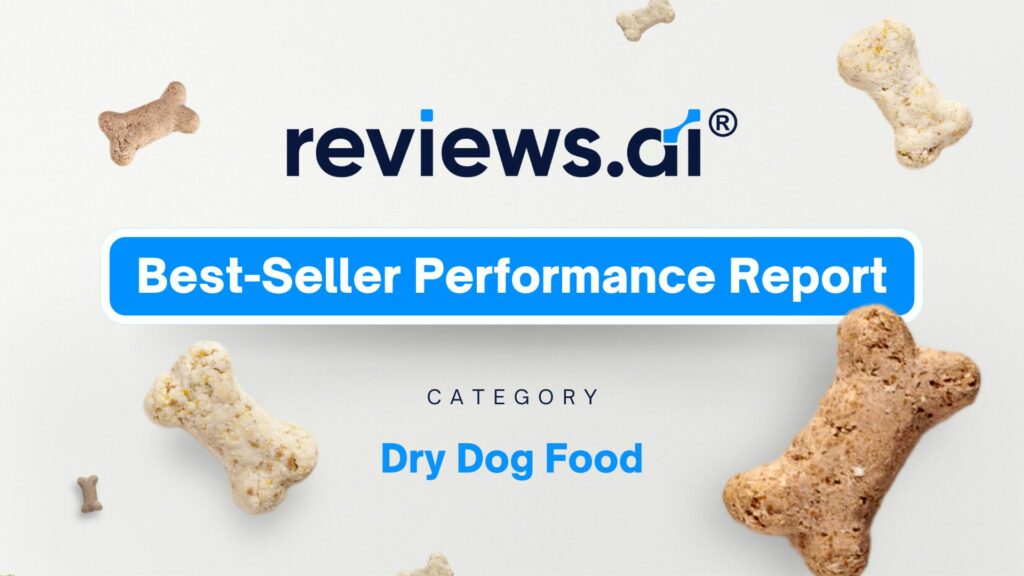 .
. 
By understanding the six key themes—Dog Preference & Enjoyment, Health & Nutrition, Quality & Safety, Service & Convenience, Brand & Trust, and Price & Value—you can see what matters most to dog owners. Focusing on these factors will help build trust, ensure satisfaction, and foster loyalty among pet owners. Marketers, product developers, and customer service leaders can use these insights to better serve their customers and succeed in the competitive pet food market. Dive into the full “Dry Dog Food – Best Seller Performance Report” for more detailed insights and actionable strategies.
In the pet food industry, staying ahead of the competition requires a deep understanding of what makes both pets and their owners happy. The insights provided by the “Dry Dog Food – Best Seller Performance Report” offer a valuable roadmap for creating products that meet the needs of today’s discerning pet owners. By focusing on the key themes of Dog Preference & Enjoyment, Health & Nutrition, Quality & Safety, Service & Convenience, Brand & Trust, and Price & Value, brands can build strong, lasting relationships with their customers.
Explore the full “Dry Dog Food – Best Seller Performance Report” for more detailed insights and strategies to boost your brand’s performance. With the right approach, you can create products that not only meet the nutritional needs of pets but also bring joy and satisfaction to their lives, ensuring long-term loyalty and success in the pet food market.
Blog Posts In This Series
- Introducing The Reviews.AI Feedback Matrix
- Understanding Dog Preference and Enjoyment: Insights from the “Dry Dog Food – Best Seller Performance Report”
- Understanding What Differentiates Leader Products in Dog Preference and Enjoyment: Insights from the “Dry Dog Food – Best Seller Performance Report”
- Meeting Health & Nutrition Demands: Insights from the “Dry Dog Food – Best Seller Performance Report”
- Understanding What Makes a Leader in Dog Food Health and Nutrition: Insights from the “Dry Dog Food – Best Seller Performance Report”
- Ensuring Quality and Safety in Dog Food: Insights from the “Dry Dog Food – Best Seller Performance Report”
- What Sets Leaders of Quality and Safety in Dog Food Apart: Insights from the “Dry Dog Food – Best Seller Performance Report”
- Service and Convenience in Buying Dog Food: Insights from the “Dry Dog Food – Best Seller Performance Report”
- What Sets Leaders of Service and Convenience in Dog Food Apart: Insights from the “Dry Dog Food – Best Seller Performance Report”
- Role of Brand and Trust in influencing Dog Food owners: Insights from the “Dry Dog Food – Best Seller Performance Report”
- Understanding What Differentiates a Leader in Brand and Trust amongst Dog Food Products: Insights from the “Dry Dog Food – Best Seller Performance Report”
- Role of Price and Value in driving Dry Dog Food Customer Experience: Insights from the “Dry Dog Food – Best Seller Performance Report”
- Understanding What Differentiates a Leader in Price and Value amongst Dog Food Products: Insights from the “Dry Dog Food – Best Seller Performance Report”

